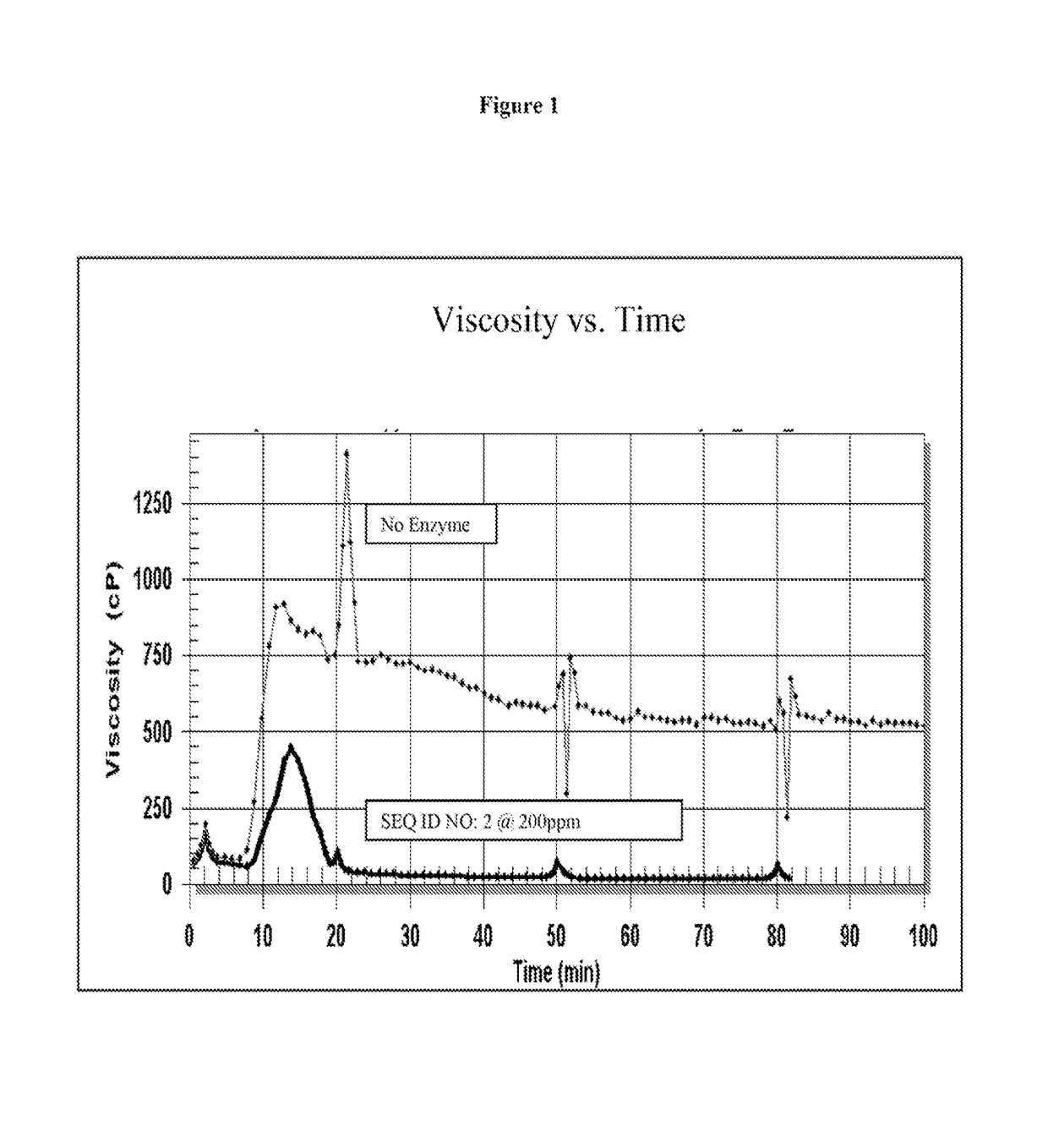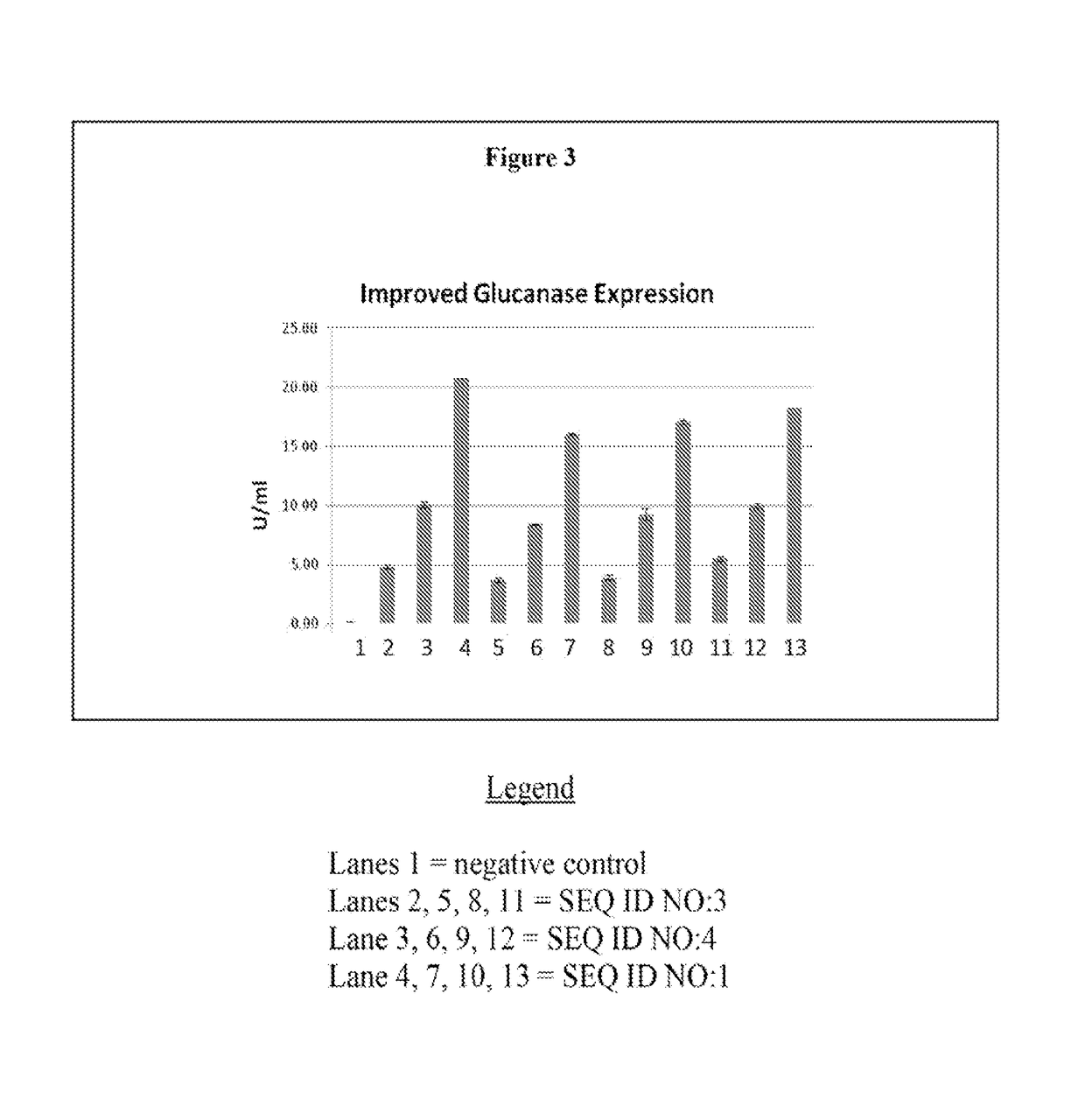Gene encoding cellulase
a cellulase and gene technology, applied in the field of gene encoding cellulase, to achieve the effect of reducing the likelihood of clogging in the system, increasing the flow rate of the flowback fluid, and reducing the viscosity
- Summary
- Abstract
- Description
- Claims
- Application Information
AI Technical Summary
Benefits of technology
Problems solved by technology
Method used
Image
Examples
example 1
Use of SEQ ID NO. 2 with Ester
[0159]Rheology testing was performed using a Grace M5600 HPHT Rheometer, two samples were assayed, one with the cellulase encoded by SEQ ID NO. 2, and the other, a control, with no enzyme. The assay conditions were as follows: sample 1, included the cellulase encoded by SEQ ID NO. 2 at 200 ppm, 0.25 pptg ester, 25 pptg cross-linked guar, at pH 10.5, at 180 degrees Fahrenheit; sample 2, included 0.25 pptg ester, 25 pptg cross-linked guar, at pH 10.5, at 180 degrees Fahrenheit. As displayed in FIG. 1, the sample including cellulase encoded by SEQ ID NO. 2 and ester at pH 10.5, and 180 degrees Fahrenheit (bottom line) reached nearly 0 centipoise (cP), whereas the control sample with no enzyme maintained a viscosity of 500 cP (top line).
example 2
Method of Making Enhanced Expression Variants
[0160]Two variants (SEQ ID NO:1 and NO: 4) were designed based on SEQ ID NO:3 to mutate at the DNA level to improve the gene expression. The design takes into account of many factors that may influence gene expression. The mutations were introduced on the PCR primers using PCR techniques known of those of skill in the art. Both genes were PCR-amplified and cloned into the Pseudomonas vector pDOW 1169 (DOW AgroSciences, IN) using standard molecular cloning techniques. The resulting expression constructs were transformed into Pseudomonas fluorescens DC454 (DOW AgroSciences, IN). A transformant with the SEQ ID NO:1 was designated as the lead as it showed the most enhanced expression.
example 3
Using SDS-PAGE Gel Electrophoresis and Nonspecific Protein Staining to Visualize Expression Levels of the SEQ ID NO:2 Polypeptide Expressed by Constructs Comprising SEQ ID NOs:1, 3, and 4
[0161]Criterion™ precast Tris-HCl polyacrylamide gel (Bio-rad Laboratories, Inc.) was used to separate proteins. The gel was run at 150V using Tris-glycine buffer (see FIG. 1). Protein loading was normalized to load proteins from 0.33 OD600 cells for each lane. SeeBlue® pre-stained protein standard was used (Life Technologies). The gel was stained with a nonspecific dye, and each lane was visually inspected for the presence of a band at the size of SEQ ID NO:2, about 37 kilodaltons.
[0162]The results indicate that there is a single band having an accumulation level which varies across samples and which is absent from the negative control. This band has a size expected for SEQ ID NO:2.
[0163]The accumulation level of this band is significantly higher in lanes corresponding to protein extracts from cell...
PUM
| Property | Measurement | Unit |
|---|---|---|
| temperature | aaaaa | aaaaa |
| temperature | aaaaa | aaaaa |
| temperature | aaaaa | aaaaa |
Abstract
Description
Claims
Application Information
 Login to View More
Login to View More - R&D
- Intellectual Property
- Life Sciences
- Materials
- Tech Scout
- Unparalleled Data Quality
- Higher Quality Content
- 60% Fewer Hallucinations
Browse by: Latest US Patents, China's latest patents, Technical Efficacy Thesaurus, Application Domain, Technology Topic, Popular Technical Reports.
© 2025 PatSnap. All rights reserved.Legal|Privacy policy|Modern Slavery Act Transparency Statement|Sitemap|About US| Contact US: help@patsnap.com



